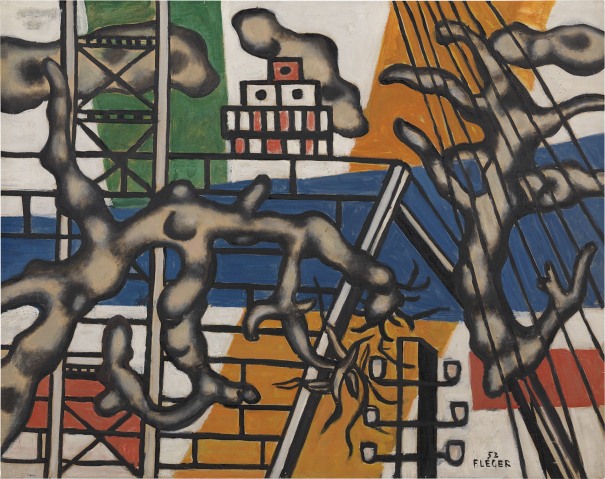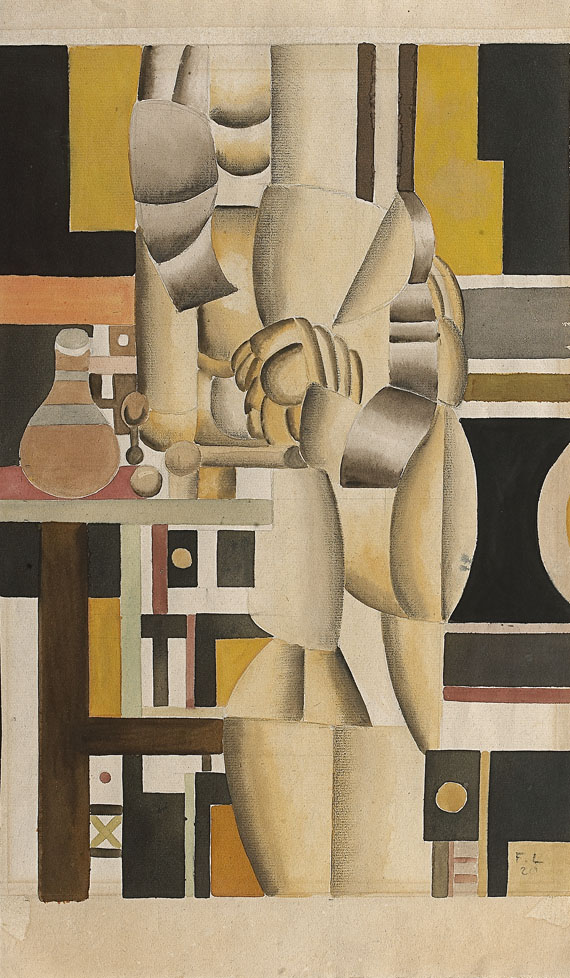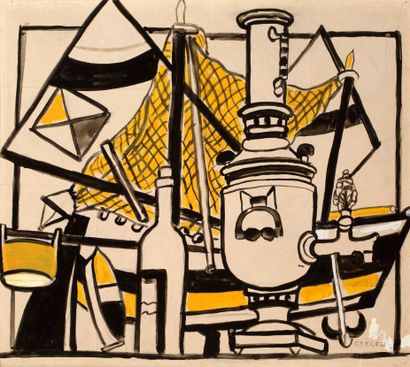Fernand Léger Objets dans l'espace (Objects in space) 1931 oil on canvas 28 3/4 x 36 in. (73 x 92.4 cm) Signed and dated "F. Léger 31" lower right; further signed, titled, inscribed and dated "F. LEGER 31 Objets dans l'ESPACE No 174" on the reverse.
Provenance Mrs. Fernand Léger the artist's widow Galerie Louise Leiris, Paris, acquired from the above, 1963 Galerie de l'Elysée, Paris Galerie Beyeler, Basel Stephen Hahn Gallery, New York Alan and Peggy Tishman, acquired from the above, 1970 Exhibited Basel, Galerie Beyeler, Fernand Léger May - June, 1964, no. 31 Stockholm, Svensk-Franska Konstgalleriet, Fernand Léger September 12 - December 2, 1968, no. 3 Literature G. Bauquier, Fernand Léger Catalogue raisonné de l'oeuvre peint (1929-1931), vol. IV. Paris, 1995, no. 791, pp. 310-311 (illustrated) Catalogue Essay “I dispersed my objects in space and kept them all together while at the same time making them radiate out from the surface of the picture.” Fernand Léger Fernand Léger’s Objets dans l’espace (Objects in Space) is a pivotal work from 1931 that demonstrates the various aesthetic forces at play in the artist’s production during this period. It expertly showcases Léger’s stylistic progression by incorporating formal components of previous avant-garde movements and anticipating elements that would go on to define his later development. Its position as an emblematic painting of the interwar period is solidified in its adoption of a refined, synchronous aesthetic brought about to advance a more ordered modern existence. European art of the interwar period saw a dramatic shift away from the fragmentation and two-dimensional abstraction that defined early 20th century avant-garde movements such as Cubism and Futurism toward an embrace of classicism and three-dimensionally modeled figures. This change was largely due to the devastation experienced during World War I and the desire amongst artists to create a new aesthetic paradigm that sought to achieve a new, more meaningful world order. The impulse of artists coming out of World War I was to find a negotiated means of representation that incorporated the art of the past with an accurate expression of modern existence. This led to a multitude of artistic discourses rooted in certain commonalities. The figure became central and compositions emphasized harmonious balance. There was a strong motivation to synthesize an ancient, classical aesthetic with modern life. Stability and a newly realized idealism dominated the art of this time. Léger was heavily impacted by the events of WWI and this resulting cultural change, an influence that can be clearly seen in his Objets dans l’espace (Objects in Space) of the present lot. In the early 1900s, Léger devised a personalized style of Cubism known for its cylindrical forms and use of primary colors. Widely abstract, these early artistic investigations only hinted at the figurative. The canvases from this conventional Cubist period are notable for their sense of movement and de-stability; the forms appear to disintegrate right in front of the viewer. Immediately following the war, however, Léger’s work took on a more streamlined, clarified sensibility that reveals a gradual return to order. Creating works that were evocative of modern industry and less abstract, the paintings from the immediate post-war period contain more perceivable forms—which were increasingly machine-like—and a greater sense of overall harmony. Markedly enthused by the technological advancements and vitality of modern life, he sought to represent its spirit with an imbued sense of classicism. It was as if Léger, through his modified forms and sleek compositions, was seeking to make sense of and give meaning to a world that had become utterly chaotic. A certain mode of realism was ascendant in Europe by the end of the 1920s that was overtly political and rooted in a glorified, heroic depiction of the working class. Léger was weary of this, seeing it as simplistic illusionism and a reversion back to nineteenth-century Academicism. Léger, himself deeply political, was concerned with accurately depicting modern life with modern artistic methods. He believed he could best illuminate the conditions of modernity by
Fernand Léger Objets dans l'espace (Objects in space) 1931 oil on canvas 28 3/4 x 36 in. (73 x 92.4 cm) Signed and dated "F. Léger 31" lower right; further signed, titled, inscribed and dated "F. LEGER 31 Objets dans l'ESPACE No 174" on the reverse.
Provenance Mrs. Fernand Léger the artist's widow Galerie Louise Leiris, Paris, acquired from the above, 1963 Galerie de l'Elysée, Paris Galerie Beyeler, Basel Stephen Hahn Gallery, New York Alan and Peggy Tishman, acquired from the above, 1970 Exhibited Basel, Galerie Beyeler, Fernand Léger May - June, 1964, no. 31 Stockholm, Svensk-Franska Konstgalleriet, Fernand Léger September 12 - December 2, 1968, no. 3 Literature G. Bauquier, Fernand Léger Catalogue raisonné de l'oeuvre peint (1929-1931), vol. IV. Paris, 1995, no. 791, pp. 310-311 (illustrated) Catalogue Essay “I dispersed my objects in space and kept them all together while at the same time making them radiate out from the surface of the picture.” Fernand Léger Fernand Léger’s Objets dans l’espace (Objects in Space) is a pivotal work from 1931 that demonstrates the various aesthetic forces at play in the artist’s production during this period. It expertly showcases Léger’s stylistic progression by incorporating formal components of previous avant-garde movements and anticipating elements that would go on to define his later development. Its position as an emblematic painting of the interwar period is solidified in its adoption of a refined, synchronous aesthetic brought about to advance a more ordered modern existence. European art of the interwar period saw a dramatic shift away from the fragmentation and two-dimensional abstraction that defined early 20th century avant-garde movements such as Cubism and Futurism toward an embrace of classicism and three-dimensionally modeled figures. This change was largely due to the devastation experienced during World War I and the desire amongst artists to create a new aesthetic paradigm that sought to achieve a new, more meaningful world order. The impulse of artists coming out of World War I was to find a negotiated means of representation that incorporated the art of the past with an accurate expression of modern existence. This led to a multitude of artistic discourses rooted in certain commonalities. The figure became central and compositions emphasized harmonious balance. There was a strong motivation to synthesize an ancient, classical aesthetic with modern life. Stability and a newly realized idealism dominated the art of this time. Léger was heavily impacted by the events of WWI and this resulting cultural change, an influence that can be clearly seen in his Objets dans l’espace (Objects in Space) of the present lot. In the early 1900s, Léger devised a personalized style of Cubism known for its cylindrical forms and use of primary colors. Widely abstract, these early artistic investigations only hinted at the figurative. The canvases from this conventional Cubist period are notable for their sense of movement and de-stability; the forms appear to disintegrate right in front of the viewer. Immediately following the war, however, Léger’s work took on a more streamlined, clarified sensibility that reveals a gradual return to order. Creating works that were evocative of modern industry and less abstract, the paintings from the immediate post-war period contain more perceivable forms—which were increasingly machine-like—and a greater sense of overall harmony. Markedly enthused by the technological advancements and vitality of modern life, he sought to represent its spirit with an imbued sense of classicism. It was as if Léger, through his modified forms and sleek compositions, was seeking to make sense of and give meaning to a world that had become utterly chaotic. A certain mode of realism was ascendant in Europe by the end of the 1920s that was overtly political and rooted in a glorified, heroic depiction of the working class. Léger was weary of this, seeing it as simplistic illusionism and a reversion back to nineteenth-century Academicism. Léger, himself deeply political, was concerned with accurately depicting modern life with modern artistic methods. He believed he could best illuminate the conditions of modernity by



.jpg)





.jpg)
.jpg)



Try LotSearch and its premium features for 7 days - without any costs!
Be notified automatically about new items in upcoming auctions.
Create an alert